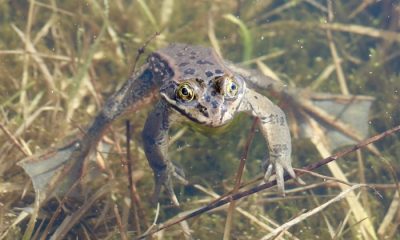Science
To Protect Wildlife from Artificial Light, Look to the Moon

|
|
Article body copy
Camilla Rathsach walked along the lichen-covered sand, heading out from the lone village on Denmark’s remote Anholt island—a spot of land just a few kilometers wide in the middle of the Kattegat Strait, which separates the Danish mainland from Sweden. As Anholt Town’s 45 streetlights receded into the distance, moonlit shadows reached out to embrace the dunes. Rathsach looked up, admiring the Milky Way stretching across the sky. Thousands of stars shone down. “It’s just amazing,” she says. “Your senses heighten and you hear the water and feel the fresh air.”
This dark-sky moment was one of many Rathsach experienced while visiting the island in 2020 for work on her master’s thesis on balancing the need for outdoor lighting and darkness. Having grown up in urban areas, Rathsach wasn’t used to how bright moonlit nights could be. And after speaking with the island’s residents, who value the dark sky deeply and navigate with little outdoor light, she realized that artificial lighting could be turned down at night depending on the moon’s phase.
At Aalborg University in Denmark, she worked with her graduate supervisor, Mette Hvass, to present a new outdoor lighting design for Anholt’s church. Rathsach and Hvass picked the church for their project because it is a central meeting place for the community yet it currently has no outdoor lights. They thought lighting would make it easier for people to navigate but wanted to preserve the inviting ambiance of moonlight.
One of the guiding principles of designing sustainable lighting is to start with darkness, and add only the minimum amount of light required. Darkness and natural light sources are important to many species, and artificial light can be downright dangerous.
“Lights can attract and disorient seabirds during their flights between colony and foraging sites at sea,” says Elena Maggi, an ecologist at the University of Pisa in Italy who is not involved in the project. Anholt’s beaches host a variety of breeding seabirds, including gulls and terns, and the island is a stopover for many migrating birds. The waters around the island are also home to seals, cod, herring, and seagrass. Though scientists have made progress in understanding the effects of artificial light at night on a range of species, such as turtles, birds, and even corals, there is still more to learn.
“We still don’t know exactly how artificial light might interact with other disturbances like noise and chemical pollution, or with rising ocean temperatures and acidification due to climate change,” says Maggi.
The scientists’ final design for the church includes path lighting and small spotlights under the window arches, along with facade lighting under the eaves shining downward. To preserve the dark sky, path lighting would turn off on bright moonlit nights, and facade lighting would shut off on semi-bright or bright nights. The window lighting would stay on regardless of the moon’s phase.
The adaptive lighting cooked up by Camilla Rathsach and Mette Hvass would automatically adjust to the availability of moonlight, tweaking this church’s lighting automatically to balance visibility and darkness. Mock-ups show how the church would be lit under no moonlight (first) and a full moon (second). Illustrations courtesy of Camilla Rathsach
“The contrast between the moon’s cold white light reflecting off the church’s walls and the warm orange lights in the windows would create a cozy, inviting experience,” says Rathsach.
The moonlight adaptive lighting design project is part of a growing effort to balance the need for functional lighting in the town and to protect the darkness. Recently, the town’s public streetlights were swapped for dark-sky friendly lamps, says Anne Dixgaard, chairman of Dark Sky Anholt.
Dixgaard also organizes a yearly walk out to Anholt’s beach, where skywatchers can learn about the night sky. “People really value Anholt’s dark sky and want to preserve it,” she says.
Rathsach and Hvass are working on the moonlight adaptive design project in hopes that it will be implemented one day, but they still have some challenges to overcome. Moonlight is a relatively faint light source, so detecting it using sensors is challenging, and lights would need to adjust automatically on nights with intermittent cloud cover. Yet big initiatives often begin with small steps.
“This work is something new and unexpected,” says Maggi. “It’s a very interesting approach to mitigating the negative effects of artificial light at night.”





Science
SpaceX sends 23 Starlink satellites into low-Earth orbit


|
|
April 23 (UPI) — SpaceX launched 23 Starlink satellites into low-Earth orbit Tuesday evening from Space Launch Complex 40 at Cape Canaveral Space Force Station in Florida.
Liftoff occurred at 6:17 EDT with a SpaceX Falcon 9 rocket sending the payload of 23 Starlink satellites into orbit.
The Falcon 9 rocket’s first-stage booster landed on an autonomous drone ship in the Atlantic Ocean after separating from the rocket’s second stage and its payload.
The entire mission was scheduled to take about an hour and 5 minutes to complete from launch to satellite deployment.
The mission was the ninth flight for the first-stage booster that previously completed five Starlink satellite-deployment missions and three other missions.





Science
NASA Celebrates As 1977’s Voyager 1 Phones Home At Last


|
|
Voyager 1 has finally returned usable data to NASA from outside the solar system after five months offline.
Launched in 1977 and now in its 46th year, the probe has been suffering from communication issues since November 14. The same thing also happened in 2022. However, this week, NASA said that engineers were finally able to get usable data about the health and status of its onboard engineering systems.
Slow Work
Fixing Voyager 1 has been slow work. It’s currently over 15 billion miles (24 billion kilometers) from Earth, which means a radio message takes about 22.5 hours to reach it—and the same again to receive an answer.
The problem appears to have been its flight data subsystem, one of one of the spacecraft’s three onboard computers. Its job is to package the science and engineering data before it’s sent to Earth. Since the computer chip that stores its memory and some of its code is broken, engineers had to re-insert that code into a new location.
Next up for engineers at NASA’s Jet Propulsion Laboratory in California is to adjust other parts of the FDS software so Voyager 1 can return to sending science data.
Beyond The ‘Heliopause’
The longest-running and most distant spacecraft in history, Voyager 1, was launched on September 5, 1977, while its twin spacecraft, Voyager 2, was launched a little earlier on August 20, 1977. Voyager 2—now 12 billion miles away and traveling more slowly—continues to operate normally.
Both are now beyond what astronomers call the heliopause—a protective bubble of particles and magnetic fields created by the sun, which is thought to represent the sun’s farthest influence. Voyager 1 got to the heliopause in 2012 and Voyager 2 in 2018.
The Pale Blue Dot is a photograph of Earth taken Feb. 14, 1990, by NASA’s Voyager 1 at a distance of … [+]
NASA/JPL-Caltech
Pale Blue Dot
Since their launch from Cape Canaveral, Florida, aboard Titan-Centaur rockets, Voyager 1 and Voyager 2 have had glittering careers. Both photographed Jupiter and Saturn in 1979 and 1980 before going their separate ways. Voyager 1 could have visited Pluto, but that was sacrificed so scientists could get images of Saturn’s moon, Titan, a maneuver that made it impossible for it to reach any other body in the solar system. Meanwhile, Voyager 2 took slingshots around the planets to also image Uranus in 1986 and Neptune in 1989—the only spacecraft ever to image the two outer planets.
On February 14, 1990, when 3.7 billion miles from Earth, Voyager 1 turned its cameras back towards the sun and took an image that included our planet as “a mote of dust suspended in a sunbeam.” Known as the “Pale Blue Dot,” it’s one of the most famous photos ever taken. It was remastered in 2019.





Science
NASA hears from Voyager 1, the most distant spacecraft from Earth, after months of quiet
|
|
CAPE CANAVERAL, Fla. (AP) – NASA has finally heard back from Voyager 1 again in a way that makes sense.
The most distant spacecraft from Earth stopped sending back understandable data last November. Flight controllers traced the blank communication to a bad computer chip and rearranged the spacecraft’s coding to work around the trouble.
NASA’s Jet Propulsion Laboratory in Southern California declared success after receiving good engineering updates late last week. The team is still working to restore transmission of the science data.
It takes 22 1/2 hours to send a signal to Voyager 1, more than 15 billion miles (24 billion kilometers) away in interstellar space. The signal travel time is double that for a round trip.
Contact was never lost, rather it was like making a phone call where you can’t hear the person on the other end, a JPL spokeswoman said Tuesday.
Launched in 1977 to study Jupiter and Saturn, Voyager 1 has been exploring interstellar space – the space between star systems – since 2012. Its twin, Voyager 2, is 12.6 billion miles (20 billion kilometers) away and still working fine.





-



 Health14 hours ago
Health14 hours agoRemnants of bird flu virus found in pasteurized milk, FDA says
-
Art19 hours ago
Mayor's youth advisory council seeks submissions for art gala – SooToday
-



 Health18 hours ago
Health18 hours agoBird flu virus found in grocery milk as officials say supply still safe
-



 Investment18 hours ago
Investment18 hours agoTaxes should not wag the tail of the investment dog, but that’s what Trudeau wants
-
News18 hours ago
Peel police chief met Sri Lankan officer a court says ‘participated’ in torture – Global News
-



 Science22 hours ago
Science22 hours agoiN PHOTOS: Nature lovers celebrate flora, fauna for Earth Day in Kamloops, Okanagan | iNFOnews | Thompson-Okanagan's News Source – iNFOnews
-
Art19 hours ago
An exhibition with a cause: Montreal's 'Art by the Water' celebrates 15 years – CityNews Montreal
-
Media13 hours ago
Vaughn Palmer: B.C. premier gives social media giants another chance





